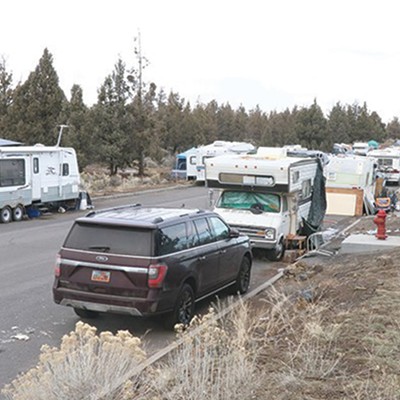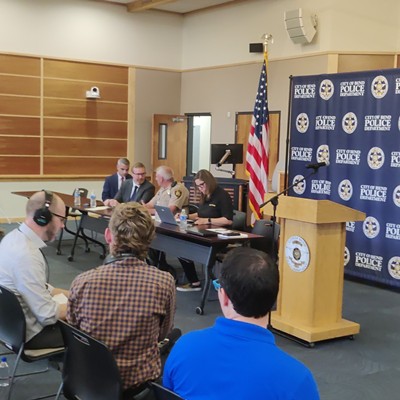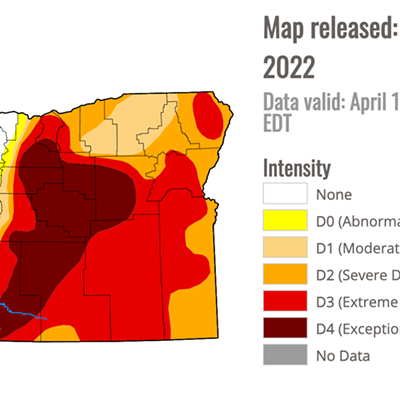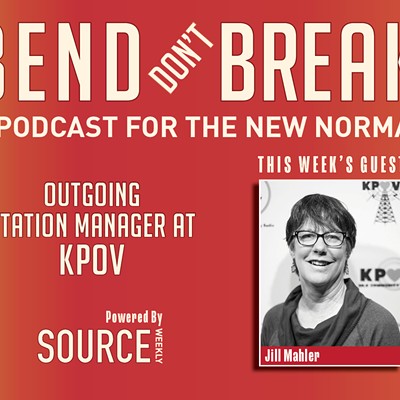Across the Northwest, the threat of an impending major earthquake looms large—so much so that the state of Oregon has created the "Cascadia Playbook" to map out emergency response coordination efforts statewide. While the local area isn't expected to suffer serious damage, Central Oregon still plays a major role in that playbook.
A History of Quakes
Although there are no written records, geologists think a major earthquake of between 8.7 and 9.2 on the Richter scale ravaged the coast of Oregon and Washington on Jan. 26, 1700. Evidence to support this claim includes tree rings dated to 1699—the last year of growth for the "ghost forests" that were killed when they dropped into tidal zones. These trees now become exposed only during low tide.
More evidence recorded by Japanese observers tells of a major tsunami that hit Japan in 1700. Further, archaeological evidence has uncovered Pacific Northwest native coastal villages that were flooded around 1700.
It's happened before, and geologists say it will happen again. Researchers at Oregon State University predict a 15 to 20 percent chance of a major quake off the central to northern coast of Oregon within the next 50 years.
The Cascadia subduction zone stretches from Northern California to Vancouver Island. Researchers say a major quake occurs between Newport and Astoria an average of every 350 years. From Astoria to Vancouver Island, a major event occurs on average every 430 years. It has been 316 years since the last event.
"The type of disaster we're looking at is nothing we've ever seen in this country," says Andrew Phelps, Oregon's director of emergency management. "This is really the worst potential natural disaster facing our country." Phelps began his career in emergency management in New York, witnessing firsthand the events of 9/11.
At St. Charles Health System, Ken Quiner is emergency management coordinator. Previously he served as emergency planning liaison for Douglas, Coos, and Curry counties —all coastal communities where the major Cascadia earthquake would take a huge toll. "As we look at the situation and play it out, they are looking at being thrust back into the 18th century—horse and buggy style with no bridges, no roads, and no resources coming in except for what's brought in from the outside by military or first responders or the Federal Emergency Management Agency."
According to Oregon's scientific modeling—and depending on the timing—an estimated 1,100 people on the coast and along the I-5 corridor could be killed during the shakedown. An additional 13,500 could lose their lives during the tsunami that would strike soon after. Statewide, as many as 440,000 residential buildings could be damaged, and up to 520,000 residents may need short-term shelter.
Central Oregon Impacts
When the Cascadia quake hits the coast and Western Oregon, Central Oregonians will feel it too. In fact, if the shake is as big as expected, at around 9.0, it will be felt by eastern Oregonians as far away as Baker City. While there's not expected to be major damage here, the shake will last longer than recent, less severe earthquakes, and the expected 'recovery duration' of vulnerable buildings could be up to 30 days.
Central and Eastern Oregon's agricultural economy could take a long-term hit, with extensive damage to shipping ports up and down the Oregon coast. Most resources—including food and fuel—that come into the Pacific Northwest come through ports in Seattle, Tacoma and Portland. Transportation lines from Western Oregon would be severed by considerable damage to bridges, highways and rail lines.
There may be energy interruptions with power outages that could last from one to seven days in Central Oregon. Natural gas lines might be severed here, and there will undoubtedly be interruptions to liquid fuel supplies such as gasoline and diesel, most of which is channeled through the Port of Portland.
According to the OEM report, Central Oregon—and Redmond in particular—will become a main staging area for the recovery efforts. The Redmond airport will become the main hub airport serving the recovery effort, with the city a support base for recovery efforts. The Deschutes County Fairgrounds could become a staging area where fuel, food, medical supplies and other supplies would be shipped to Western Oregon. The fairgrounds and other locations might also serve to shelter western Oregonians who were able to escape and head east over the mountains. Initial response, including rescue efforts, could take up to eight or more days before recovery efforts—including the ability to shelter large numbers of people—could even begin.
"I think there is going to be a natural instinct for a lot of people in the Willamette Valley and along the I-5 corridor to move away or evacuate out of the area," says Andrew Phelps at the state's Office of Emergency Management. "There would be a shortage of food, water supplies and medical supplies, so there will be a tendency for people to head east where those things are available."
Local Efforts
Sgt. Nathan Garibay is emergency coordinator for the Deschutes County Sheriff's Department. He is a busy man, attending an increasing number of meetings to prepare Central Oregon for the big shake. "We are really starting to ramp up trying to make sure our communities are prepared to not only take care of our own population but to help support the response to Western Oregon," he said. "This will be a catastrophic event for them."
Garibay and his colleagues are working on plans to provide emergency fuel to the region after the event, including a fuel-rationing program to ensure continuation of essential government services.
With an influx of first responders and the expected migration from coastal areas, other facilities including schools, gymnasiums, churches and government buildings would be utilized to provide services, including housing. "We have a responsibility to take care of our own population but also populations that are displaced here," says Garibay. He says the region would be limited as to how large a population could be sheltered locally. For those displaced, it could be weeks or even months before they could return home.
Many of those displaced will need emergency medical treatment, and Garibay says that will place a significant strain on medical services in Central Oregon. Hospitals in the Portland area and the Willamette Valley would be severely impacted, leaving St. Charles Health System in Bend as the only trauma care facility likely to be in operation.
Medical Preparation
At St. Charles, Emergency Management Coordinator Ken Quiner is equally as busy as Garibay ensuring the hospital functions at maximum capacity during an expected emergency. "Right now we are implementing plans for the current winter storms, but those plans are applicable for the larger Cascadia event," he says. Quiner says it's critical to keep transportation lines open for staff and supplies.
For Quiner, it's a matter of planning for transportation problems, fuel shortages, emergency power, emergency water and other planning for the worst-case scenarios. He also draws on lessons learned from other natural disasters, such as the world's largest-ever recorded earthquake, a 9.5 event that happened in Chile in 1960.
"We want to maintain the ability to provide medical care to our communities despite what's happening as best as possible," he reflects.
Quiner says St. Charles should be functional because facilities are built to code. "We do have concerns about fuel. We have backup generators but need to have the fuel to run them. We have the ability to store fuel, but we're working with our community partners on how to best store fuel without it going to waste." Quiner says St. Charles' backup generators and fuel supplies should be able to operate for a month "or so."
Individual Preparation
At home, Sgt. Garibay says everyone should be prepared for an emergency and have a plan of action. "Be prepared to live on your own for two weeks without critical services. Here in the tri-county area, we say two weeks is the minimum but 30 days is best." Another recommendation: Keeping vehicle gas tanks at least half full.
At the American Red Cross – Cascades Region, Monique Dugaw says her organization offers a wide range of preparedness education programs, including a presentation called "Prepare Out Loud." More than 5,000 people have attended those presentations, including a recent audience of 400 at Bend's Tower Theatre.
The Red Cross offers a "Prepare Guide" for region-specific disasters. It also has created a resource page on its website specifically for the Cascadia earthquake at redcross.org/PrepareOutLoud.

























